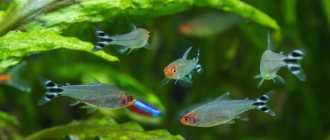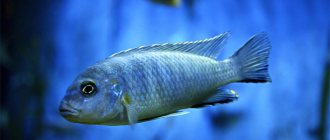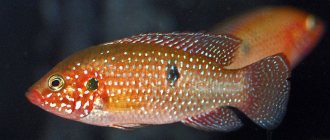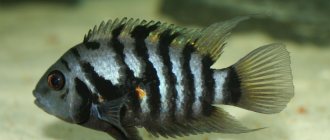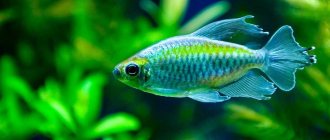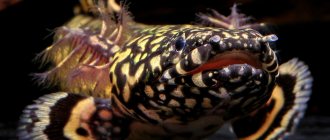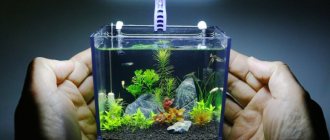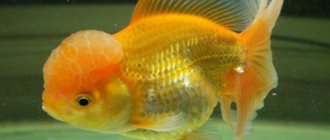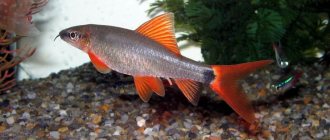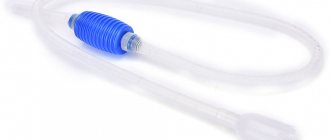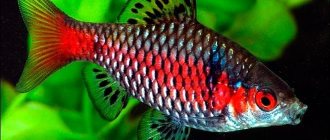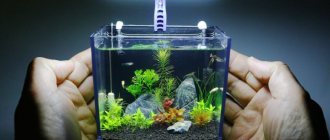Congo tetra (Phenacogrammus interruptus) Boulenger, 1899
It is a representative of the African Characinidae species, which was described by the biologist Boulanger back in 1899.
Synonyms
Russian: Rainbow Congo/Tetra, Blue Congo/Tetra, Tetra Congo, Royal Congo
Etymology
Phenacogrammus: Greek, phenax, - akos = deceptive + Greek, gramma = letter, signal.
Family: African tetras (Alestidae) Genus: Phenacogrammus tetras
Range and Habitat
Congo tetra (Phenacogrammus interruptus) distribution areas.
Distributed in Africa. Wild populations are endemic to parts of the rivers of the Congo Basin in the Democratic Republic of the Congo.
Congo tetra (Phenacogrammus interruptus) typical habitat.
These fish stay in small schools and prefer “black” water.
Most commercially available fish are bred for sale in Asia and Eastern Europe.
General information
Tetras is the collective name for various species of fish from the Characin family. These are small, agile and colorful fish that are a pleasure to watch. They live mainly in the rivers of South America and live in flocks.
Aquarists all over the world love tetras for their ease of keeping, bright colors and excellent compatibility with most species of small tropical fish. Tetras do not require large aquarium volumes and reproduce easily. You can meet them both in the aquariums of beginners and professionals.
It is necessary to keep fish in schools of 6-10 individuals or more. Tetras living alone either become inactive or, on the contrary, become cocky and begin to attack their neighbors in the aquarium.
A flock of red-nosed tetras
Description
The body of the fish is elongated and flat on the sides. The fins spread out in lush fans on the sides of the body during movement.
Congo tetra (P. interruptus) appearance.
In the aquarium it displays a beautiful color that shimmers beautifully in the water. It comes in blue, red-orange and golden-yellow shades. The fins have more muted tones, these are translucent, gray-violet shades.
Congo tetra (P. interruptus) appearance, close-up.
When mature, the Congo Tetra's rainbow colors run through the fish from front to back, starting with blue at the top, transitioning to red through the middle, to yellow and gold, and back to blue just above the belly.
Congo tetra (P. interruptus) albino form, appearance.
There is also an albino form.
Size:
They are classified as medium-sized fish. Adults reach a size of 8-10 cm in length if we are talking about males. Females are usually slightly smaller - about 6 centimeters.
Types of koi carp
Koi carp come in a wide variety of colors, the main ones being: white, black, red, yellow, blue and cream. There are more than 80 breeds of koi. For convenience, they are divided into 16 groups, united by one or more common characteristics. The most popular Koi breed is the Gosanke, which includes the Kohaku, Taisho Sanshoku and Showa Sanshoku varieties.
Kohaku is a white carp with distinct red or red-orange spots on its back.
Taisho sanshoku, or sanke, is a white carp with red and black spots. Named after Emperor Taisho.
Showa sanshoku, or showa, is a black carp with red and white spots. Named after Emperor Showa.
Tancho - koi of any color with a red spot on the head. "Tancho" can be called either tancho showa or tancho sanke, or tancho goshiki.
Asagi are koi with blue scales on the back and red (red-orange) scales on the sides.
Shusui is a kind of extended version of the asagi variety: the back of the carp is blue, and there are red (red-orange) spots on the sides.
Bekko is a white, red or yellow carp with black spots.
Utsurimono is a black koi with red, yellow or white markings.
Goshiki is a predominantly black koi with red, white, brown and blue markings.
Ogon is a solid colored koi, the most common colors being red, orange, grey, yellow and light yellow.
Kinginrin (Kinrin/ginrin, kinrin/ginrin) – koi with sparkling golden (ginrin) or silver (kinrin) scales.
Kawarimono, or kawarigoi, are various koi that cannot be classified into any of the identified varieties.
Doitsu-goi are German carp that have no scales at all or have several rows of scales, like mirror carp.
Koromo is a white koi covered with neat black and red spots.
Hikari-moyomono is a koi with a metallic sheen and a combined golden-silver color.
Ghost koi is a “hybrid” of ogon and wild carp. Not a nishikigoi.
Veiled koi (dragon carp; butterfly koi) – koi of all listed species with a longer body. Not a nishikigoi.
Behavior and Compatibility
This is an amazingly beautiful, active, peaceful, schooling aquarium fish. It is advisable to keep them in large aquariums as they need a lot of space to swim. In addition, it is important that the lighting in the aquarium is dim. These fish are quite shy and secretive, especially if there are other aggressive species in the aquarium. They may become frightened by loud noises and sudden movements nearby.
Congo tetra (Phenacogrammus interruptus) in aquarium 1.
Recommended for most community aquariums, however, keep in mind:
Congo tetra (Phenacogrammus interruptus) in aquarium 2.
They are also quite shy fish, especially if they are not kept in a school; it is recommended to keep 6 or more individuals. It is also important that they are surrounded by fish of similar sizes. Rainbowfish, Corydoras and various peaceful cichlids will be excellent neighbors. They should not be housed with aggressive fish or those that are capable of biting their fins - the spectacular fins of the males will simply be destroyed. Small fish in a community aquarium with this tetra will not feel comfortable due to their larger size and more active behavior.
Not suitable for keeping with shrimp.
Possible problems
The Congo fish is sick due to improper conditions. Impaired filtration, small aquarium volume, etc. - all this leads to the accumulation of poisons in the water. The immunity of individuals drops, and they begin to get sick. Therefore, if the inhabitants of the aquarium begin to die, the first thing you need to do is check the conditions of detention and put them in order.
If fluff appears on the fish, it is sick
Stress is also a risk factor. It is caused by small spaces and aggressive neighbors. Intimidated individuals are distinguished by unusual behavior, pinched fins and pale color. Buying and transporting fish itself is stressful for her. To reduce it, turn off the aquarium lighting and do not disturb it for 12 hours after putting the newcomer into the water.
The appearance of fluff, moss and cotton wool on the body of the fish is a consequence of fungal diseases. With bacterial lesions, swellings, ulcers, bruises or mucus appear on the scales. It is better to place sick individuals in a separate aquarium for the duration of treatment. It is advisable to do this if any suspicious symptoms appear. The use of medications is discussed with a veterinarian , since each case requires an individual approach.
Aquarium
The size of the aquarium is 120*30*30 cm for a group of adult fish; young fish can be kept in smaller aquariums.
Congo tetra (Phenacogrammus interruptus) in aquarium 3.
If they are kept in small numbers, about six individuals, then an aquarium of 100 liters or more will suit them. The fish will be less shy if the aquarium uses dark soil and dim lighting. This kind of light can be created by adding plants to the aquarium that will float on the surface of the water.
Congo tetra (Phenacogrammus interruptus) in aquarium 4.
Ideally, an aquarium with an African biotope, with driftwood and branches, floating vegetation and Anubias. They will show you their best colors in any well-maintained aquarium with plenty of swimming space. The water should be on the acidic side, neutral or soft, with good circulation.
Water parameters:
Temperature: 23 - 28° C pH: 6.0 - 7.5 Hardness: 3 - 18° dGH
Regular water changes of 20-25% per week.
Very sensitive to water quality and if good quality is not maintained, male fin development may be impaired and the fish will lose color.
Keeping koi carp in a pond
In captivity, Japanese koi can live quite a long time, ranging from 25 to 35 years.
There are known cases of very decent age of fish - 220 years. Koi carp can grow up to 130 centimeters in length, which is typical for some breeds that are genetically closer to their ancestor, the wild carp. But usually their length does not exceed 90-100 centimeters.
With that said, it is of course better to keep koi in a pond rather than an aquarium.
The pond can be built on a concrete base and soft waterproofing. The latter uses synthetic rubber (EPDM). With its help you can create ponds of any shape and size. If there are sharp stones in the ground, then it is also necessary to use fleece (a special backing), which will prevent damage to the EPDM film used. A pond with a concrete base is more expensive, but also the most durable. A concrete pond allows you to create steep vertical banks, which saves space while increasing the water volume of the pond. Forum about keeping fish in a pond here.
Do-it-yourself pond in the home garden #1#2#3#4#5#6
Recommended minimum pond sizes:
— depth from 1.4 m.
— volume 8 tons (3m x 2.46m x 1.23m).
It should be remembered that these brocade koi are quite active fish, they need to swim, and accordingly they need a spacious pond. Naturally, there is no specific data on how deep and volume the pond should be, since it all depends on how many koi carps you want to put in the pond.
Recommendations for the location of the pond: a quiet, calm corner of the garden (as far as possible from noisy places, such as roads), but close to the house (so that you can admire the koi in any weather without leaving the house). The sun's rays should illuminate the pond all day.
During melting snow or rain, water from the adjacent areas should not flow into the pond. To do this, a storm drainage is built around the pond or the pond is created elevated.
It is important to equip the pond with a powerful two-stage filtration system: biological and mechanical. It must guarantee the effective removal of fish waste products and nitrogen cycle products: ammonia, nitrite and nitrate from water, as well as maintain normal gas conditions
In a flowing, large pond with aquatic plants, in principle, the filtration system can not be used. But there is a chance that koi will begin to eat underwater vegetation or dig in the ground in search of food. Therefore, the optimal options for setting up a filtration system are: build an additional regeneration pond with aquatic plants or create a bioplato - a stream or small pond, entirely covered with pebbles with aquatic plants planted in it, through which water will circulate from the pond.
Most of the factors that affect biological balance depend on the volume of the pond: the amount of dissolved oxygen, temperature conditions. Thus, the larger the pond, the easier it is to maintain biological balance.
Sexual Dimorphism
The male is larger and much more brightly colored.
Congo tetra (P. interruptus) male and female, pair, difference.
Males are also distinguished by long veil-like processes that are located on the tail, as well as the dorsal and anal fins. In addition, the male has a three-lobed tail, in which the middle blade protrudes slightly forward.
Congo tetra (P. interruptus) female, difference, appearance.
These fish are capable of reproduction when they reach the age of about 10 months.
Breeding
Reproduction is not easy, but it may be an egg-laying species.
Producers select active and most brightly colored males and larger females, which were previously intensively fed using live and frozen food.
A small spawning aquarium with a net on the bottom. The eggs pass through the mesh cells, which minimizes the risk of being eaten by the parents. To stimulate spawning, the lighting should be dimmed and plants added, since in nature spawning occurs among vegetation. The water should be below neutral pH and soft.
Water parameters in the spawning aquarium: 25-28° C; dH 2-3°; pH 6.0-6.5.
After the male pursues the female, spawning occurs. Up to 300 large eggs can be spawned by a single female during spawning, although numbers of 100-200 are more common.
Congo tetra (P. interruptus) juvenile, appearance.
During the first 24-48 hours of incubation, unfertilized and whitened eggs should be removed using a long pipette. The larvae hatch in about 6 days, when they swim and the yolk sacs disappear (about 24 hours), ciliates should be offered, and then after 2-3 days Artemia nauplii or other microfood.
You can plant a group of fish at once for spawning. At the same time, it is important that the spawning aquarium be more spacious.
The Congo tetra (P. interruptus) is an excellent choice for the community aquarium.
Typically, the life expectancy in an aquarium under favorable conditions is about five years.
Feeding
An omnivorous fish that feeds on small worms, insects, crustaceans, algae and other zooplankton in nature. In an aquarium, feeding it is not difficult; almost all types of food are suitable, but live and frozen food should make up a good proportion of the diet for the fish to show its best coloring.
Congo will also eat artificial food without any problem: flakes, granules, the main thing is that the fish can swallow them.
But these are rather timid fish, they cannot keep up with their lively neighbors and may not even take food while you are nearby. It is advisable to feed them in separate portions.
